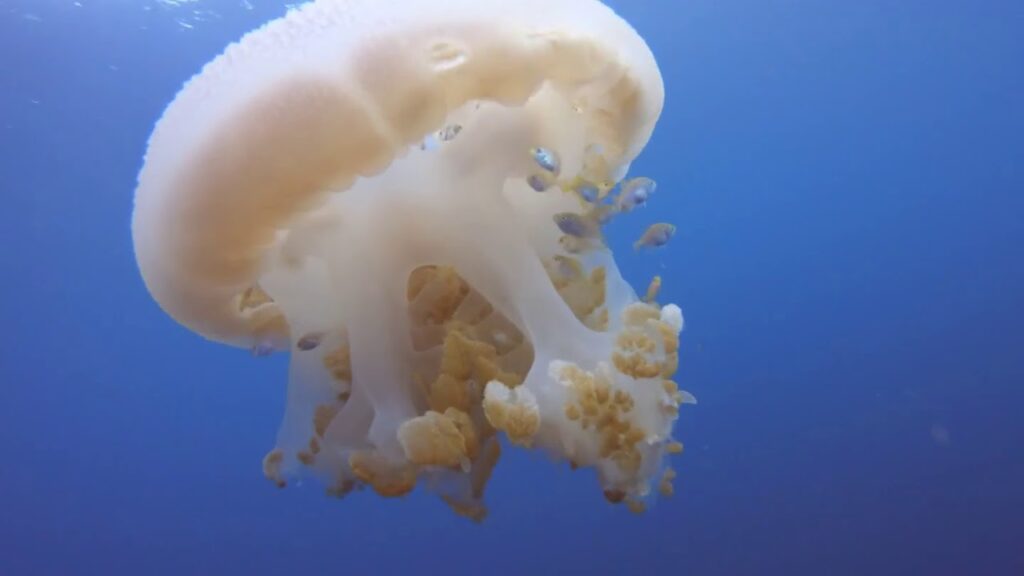Beachcombing Guide
Coastal treasures commonly found on the beach strand at Holden Beach
Angel Wings
Auger
Babys Ear
Banded Tulip
Bay Scallop
Calico Clam
Calico Scallop
Cockle
Coquina Clams
Coral
Cross-barred Venus
Cross-hatched Lucine
Disk Dosinia
Eastern Oyster
Elegant Dosinia
Florida Horse Conch
Imperial Venus Clam
Jackknife
Jingles
Keyhold Limpet
Kitten’s Paw
Lion’s Paw
Moon Snail / Sand Collar
Murex
Northern Quahog
Olive
Oyster Drillers
Pen Shell
Periwinkles
Ponderous Ark
Sand Dollars / Sea Biscuit
Scotch Bonnet
Sea Urchin
Shark Tooth
Slipper Snail
Soft Shelled Clam
Southern Quahog
Spiny Jewel Box Clam
Starfish
Sunray Venus
Surf Clam
Turkey Wing Ark Clam
Whelks
Whelks Egg Case Strings
Wing Oyster
Angel Wings
Pholadidae, commonly referred to as angel wings or piddocks, are a family of bivalve mollusks similar to a clam. Angel wings are chalky white in color and measure four to eight inches in length. The muscles fusing the shell’s valves together are weak, making it rare to find angel wings with both halves still intact.

Auger
The Terebridae, commonly referred to as Auger shells or Auger snails, is a group or family of small to large predatory marine gastropods in the superfamily Conoidea. Augers have extremely high spired shells with numerous whorls, and the common name refers to the resemblance of their shells to rock drill-type drill bits.

Babys Ear
Sinum perspectivum, commonly referred to as baby ear, is a species of predatory sea snail, a marine gastropod mollusk in the family Naticidae, the moon snails. It has a shallowly coiled shell with a wide opening and graceful curved outline.

Banded Tulip
Cinctura lilium, commonly referred to as the banded tulip, is a species of sea snail, a marine gastropod mollusk in the family Fasciolariidae. This smooth, gracefully shaped beauty has a moderately thin shell. Colors range from pearly gray with splotches of olive green or tan. It may also have dark brown bands in parallel lines around the shell and can be from 2 to 4 inches.

Bay Scallop
Argopecten irradians, commonly referred to as the bay scallop, is a marine bivalve mollusk in the family Pectinidae, a species of scallop. The shell of a bay scallop is broadly fan shaped with more than 14 radial ribs. They usually have a molted pattern and come in all sizes and colors.

Calico Clam
Macrocallista maculata, commonly referred to as the calico clam, is a species of bivalve mollusk in the family Veneridae.
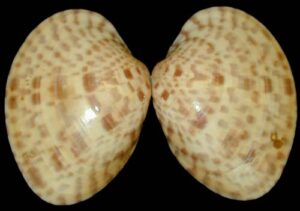
Calico Scallop
Argopecten gibbus, commonly referred to as the Atlantic calico scallop, is a species of medium-sized edible marine bivalve mollusk in the family Pectinidae, the scallops. The shell near the hinge is extended into “ears”, as is the case in all scallops. The fan-shaped shell of the calico scallop has about 20 radial ribs, which are sometimes roughened by growth lines. It is similar in shape and sculpturing to the bay scallop. Though similar the stripes are often more pronounced on the Calico Scallop and is more coveted of the two, as it’s flecked with pretty patches of rose, pink, and red.

Cockle
A cockle is an edible, marine bivalve mollusk. Although many small edible bivalves are loosely called cockles, true cockles are species in the family Cardiidae. The distinctive rounded shells are bilaterally symmetrical and are heart-shaped when viewed from the end.

Coquina Clams
Donax is a genus of small, edible saltwater clams, marine bivalve mollusks. The genus is sometimes known as bean clams or wedge shells; however, Donax species have numerous different common names in different parts of the world. These shells are small – about the size of a fingernail and is characterized by its smooth surface and its dual shell and come in a rainbow of pastel but brilliant colors.

Coral
Marine invertebrates in the class Anthozoa of phylum Cnidaria, come from the shelf edge, approximately 75 miles offshore, known as “Outer Shelf Reefs.”. Coral are reef builders that inhabit oceans and secrete calcium carbonate to form a hard skeleton.

Cross-barred Venus
Chione cancellata, is a species of medium-sized saltwater clam, a marine bivalve mollusk in the family Veneridae, the venus clams. The cloudy white to yellow-white shells are highly distinctive, with raised, bladelike concentric ridges superimposed on strong radial ribs and giving the shells their characteristic cancellate (crisscrossed) appearance.

Cross-hatched Lucine
Divaricella quadrisulcata, commonly referred to as the cross-hatched lucine, is a species of bivalve mollusk in the family Lucinidae. They are generally white in color and have a little tip at one end of their circular shell.

Disk Dosinia
Dosinia discus, commonly referred to as the disk dosinia, is a species of bivalve mollusk in the family Veneridae. They are white, flattened, and nearly circular. There are numerous fine concentric ridges with a varnish like layer that covers the shell.

Eastern Oyster
Crassostrea virginica, commonly referred to as the eastern oyster may also be called the east coast oyster. Like all oysters, it is a bivalve mollusk with a hard shell, which protects it from predation. This particular type of oyster has an important environmental value because it is a filter feeder, cleaning the water around them.

Elegant Dosinia
Dosinia elegans, commonly referred to as the elegant dosinia, is a species of bivalve mollusk in the family Veneridae.

Florida Horse Conch
Triplofusus papillosus, commonly referred to as the Florida horse conch, is a species of extremely large predatory sea snail, a marine gastropod mollusk in the family Fasciolariidae. Although known as a horse conch, this is not a true conch, this species is the largest gastropod in the American waters.

Imperial Venus Clam
Lirophora latilirata, commonly referred to as the imperial venus clam, is a bivalve mollusk in the family Veneridae. The shell is rounded, triangular and well-inflated, with large, heavy concentric ridges which are often sharply shelved at the top.

Jackknife
Ensis leei, commonly referred to as the jackknife clam is a large edible marine bivalve mollusk. This shell is most noted for its length. It is primarily a silver, gray color and is shaped like a straight razor. It is primarily a silver, gray color and is shaped like a straight razor. Also known as a razor clam, it gets its name from the rim of the shell being extremely sharp.

Jingles
Anomia is a genus of saltwater clams, marine bivalve mollusks in the family Anomiidae. They have translucent shells and are commonly known as Jingle Shells because when a handful of them are shaken they make a jingling sound.

Keyhold Limpet
Fissurellidae, are limpet-like sea snails, marine gastropod mollusks in the clade Vetigastropoda. The name comes from the small hole in the apex of their cone-like shells. It looks like a volcano with a single hole at the peak.

Kitten’s Paw
Plicatula gibbosa, commonly referred to as the kitten’s paw, is a species of bivalve mollusk in the family Plicatulidae. The shell resembles the foot of a kitten, it is fan shaped with distinct wavy ribs on the outside.

Lion’s Paw
Nodipecten nodosus, commonly referred to as the lion’s paw scallop, is a species of bivalve mollusk in the family Pectinidae. The shell’s common name is derived from its appearance, the color, and the knobs giving it some visual similarities to the paw of a lion.

Moon Snail
Naticidae, are predatory sea snails, marine gastropod mollusks in the clade Littorinimorpha. They will attack almost any other shelled mollusk they encounter in the sand, including other moon snails. They are broad, circular shells that feature a central spiral that gets larger until it reaches an equally circular opening. Also called a shark eye, it has four to five whorls that spiral inward to form the “eye”.

Moon Snail – Sand Collar
Sand collars are the characteristic egg masses of one family of sea snails, the moon snails. These egg masses are often found washed up either whole, or sometimes in fragments, on sandy beaches where moon snails are living.

Murex
Murex is a genus of medium to large sized predatory tropical sea snails. These are carnivorous marine gastropod mollusks in the family Muricidae, commonly referred to as murexes or rock snails. This genus includes many showy members, their elongate shells highly sculptured with spines or fronds.

Northern Quahog
Mercenaria mercenaria, commonly referred to as a quahog, round clam, or hard-shell clam, is an edible marine bivalve mollusk that is native to the eastern shores of North America. The shell is thick with fine concentric rings. It is one of many unrelated edible bivalves that in the United States are frequently referred to simply as clams.
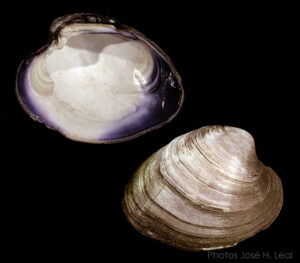
Olive
Olividae, commonly referred to as olives, are marine gastropod mollusks in the family Olividae. They are carnivorous sand-burrowers in the taxonomic family of medium to large predatory sea snails. With smooth, shiny, cylindrical shaped shells these shells are distinctive for their tight spiral top, their long and skinny opening, and their modest size. They are also the official state shell of South Carolina.

Oyster Drillers
Urosalpinx cinerea, commonly referred to as the oyster drill or eastern oyster drill, is a species of small predatory sea snail, a marine gastropod mollusk in the family Muricidae, the murexes or rock snails. The oyster driller is a small, predatory snail with a pointed, ribbed shell. The oyster driller grows to about one inch in length. Its oval-shaped shell varies in color from gray or purplish to tan or yellowish-white and has a pointed spire or tip. The shell has five to six raised whorls; brown, spiraling vertical ribs; and a thin, flared lip with small teeth.

Pen Shell
Pinna nobilis, commonly referred to as the noble pen shell or fan mussel, is a large species of Mediterranean clam, a marine bivalve mollusk in the family Pinnidae. Its shape differs depending on the region it inhabits. Delicate and beautiful they are distinctive for its iridescent exterior which can exude a rainbow of colors in the light.
Atrina serrata, or saw-toothed pen shell; thin and fragile, it has a that’s ridged and colored a deep, smoky brown.
Atrina rigida, commonly called the rigid pen shell; they have a long, triangular, or wedge-shaped shell. They are a brown or purplish-brown color and have 15 or more radiating ribs that fan out across the shell.

Periwinkles
Littorina littorea, commonly referred to as the common periwinkle is a species of small edible whelk or sea snail, a marine gastropod mollusk that has gills and an operculum, and is classified within the family Littorinidae, the periwinkles. These shells are distinctive for their conical shapes and intricate forms.
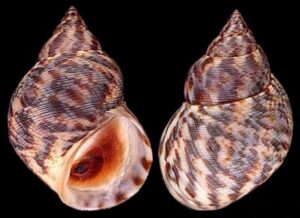
Ponderous Ark
Noetia ponderosa, commonly referred to as the ponderous ark clam, is a clam in the family Noetiidae. 
Sand Dollars
Sand dollars are species of flat, burrowing sea urchins belonging to the order Clypeasteroida. Some species within the order, not quite as flat, are known as sea biscuits. This round sea urchin is tan to light brown, have a fivefold radial pattern, and its five slots resemble keyholes. The sand dollar you find on the beach is actually the skeleton of a variety of sea urchin. Dead Sand Dollars are commonly found with their empty test devoid of all surface material and bleached white by sunlight. Living Sand Dollars, those that are brown or green and sport fuzz, should be gently returned to the sea.

Sea Biscuit
Fossilized Sand Dollars

Scotch Bonnet
Semicassis granulate, commonly referred to as the Scotch bonnet, is a medium-sized to large species of sea snail, a marine gastropod mollusk in the subfamily Cassinae. The common name “Scotch bonnet” alludes to the general outline and color pattern of the shell, it is named for its resemblance to the caps and plaid worn by the Scottish. This gorgeous shell features a conical shape, with a ridged body often covered with brown speckles. Scotch bonnets, especially intact ones, are an incredibly rare find. They are also the official state shell of North Carolina.

Sea Urchin
Arbacia punctulate, has a flattened, globular, calcareous shell made up of skeletal plates.

Shark Tooth
Sharks continually shed their teeth. Coastal North Carolina is a hot spot for shark teeth because sharks live along the coast and the region is situated above fossil deposits.

Slipper Snail
Crepidula fornicata, commonly referred to as the slipper snail, boat shell, quarterdeck shell, fornicating slipper snail and slipper limpet. This is a species of medium-sized sea snail, a marine gastropod mollusk in the family Calyptraeidae. The sea snail has an arched, rounded shell. On the inside of the shell there is a white “deck”, which causes the shell to resemble a boat or a slipper.

Soft Shelled Clam
Mya arenaria, commonly referred to as soft-shell clams, popularly called steamers, softshells, piss clams, Ipswich clams, or Essex clams are a species of edible saltwater clam, a marine bivalve mollusk in the family Myidae. These shells are very thin and easily broken, hence the name “soft-shells.” They can be white, cream, brown, gold, or gray.

Southern Quahog
Mercenaria campechiensis, commonly referred to as a southern quahog, is a genus of edible saltwater clams, marine bivalve mollusks. It is a large member of the Venus Clam family Veneridae that may grow to be 6 inches in size. The species is very similar to the northern quahog.

Spiny Jewel Box Clam
Arcinella cornuta, commonly referred to as the spiny jewel box clam, is a species of bivalve mollusk in the family Chamidae. The shell itself is thick and heavy for its size. Fresh shell specimens will have more distinct erect tubular spines on the 7-9 rows (ribs) across the shell, radiating from the beak. The shells are commonly found on southern beaches, but most of the spines have been broken off by the surf.

Starfish
Asterias rubens, commonly referred to as the common starfish, which is not a fish but are star-shaped echinoderms. Belonging to the family Asteriidae, the common starfish normally has five arms, broad at their base and gradually tapering to a point at their tips, which are often turned up slightly.

Sunray Venus
Macrocallista nimbosa, commonly referred to as the sunray venus clam, is a species of bivalve mollusk in the family Veneridae.
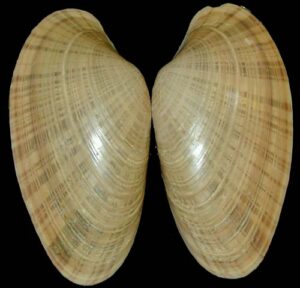
Surf Clam
Spisula solidissima, commonly referred to as the surf clam, bar clam, hen clam or skimmer. It is a very large, edible, saltwater clam, or marine bivalve mollusk in the family Mactridae.

Turkey Wing
Arca zebra, commonly referred to as the turkey wing ark clam, is a bivalve mollusk in the family Arcidae, the ark clams.
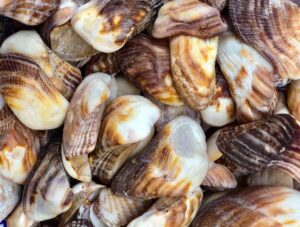
Whelks
Whelks are a species of large predatory sea snail, a marine gastropod mollusk, a busycon whelk, belonging to the family Busyconidae. Often mistaken for conch shells, whelks are noted for being striking in appearance. They have conical shapes with spiral tops, and often have wide openings. Depending on the species, some shells have spikes or ridges towards the top. The three most common varieties of whelks include Lightning Whelks, Knobbed Whelks and Channel Whelks. To identify the Lightening Whelk from the Channel Whelk, remember this: Lightening’s open on the left, and Channeled Whelks open on the right.

Lightning Whelks are similar appearance to the Knobbed Whelk but with a left-side opening. This means the snail is left-handed and the body is on the left as it travels forward with the spire in the rear.

Knobbed Whelks have several triangular knobbed spirals that taper to a long siphon canal.

Channeled Whelks are easy to classify with its deep channeled spirals and weak knobbs, if any.

Whelks Egg Case Strings
Whelks lay their eggs in a long, spiral-shaped casing that can reach up to 33 inches in length. The strand contains up to 200 small pouches, and each pouch contains up to 99 eggs. The female protects the string of eggs by anchoring one end at the bottom of the ocean.

Wing Oyster
Pteria colymbus, commonly referred to as the winged oyster is a species of bivalve mollusk in the family Pteriidae. The wing oyster has a distinctive, asymmetric shape. It has a long straight hinge with one wing drawn out a long way and the other one much smaller. On the beach, they look like a broken cockle shell, if you don’t notice the wings.








